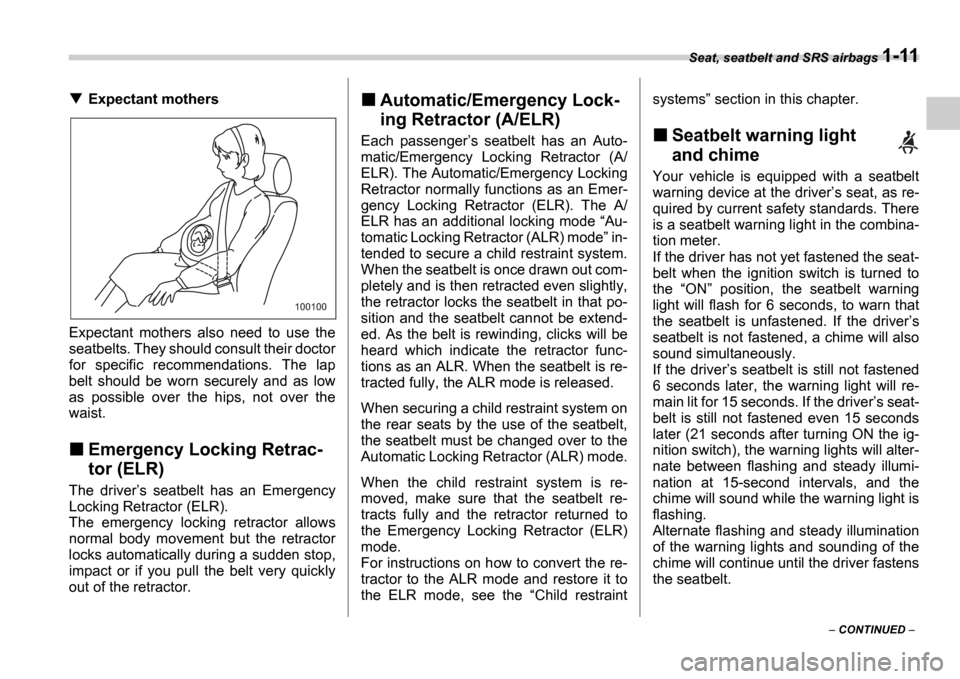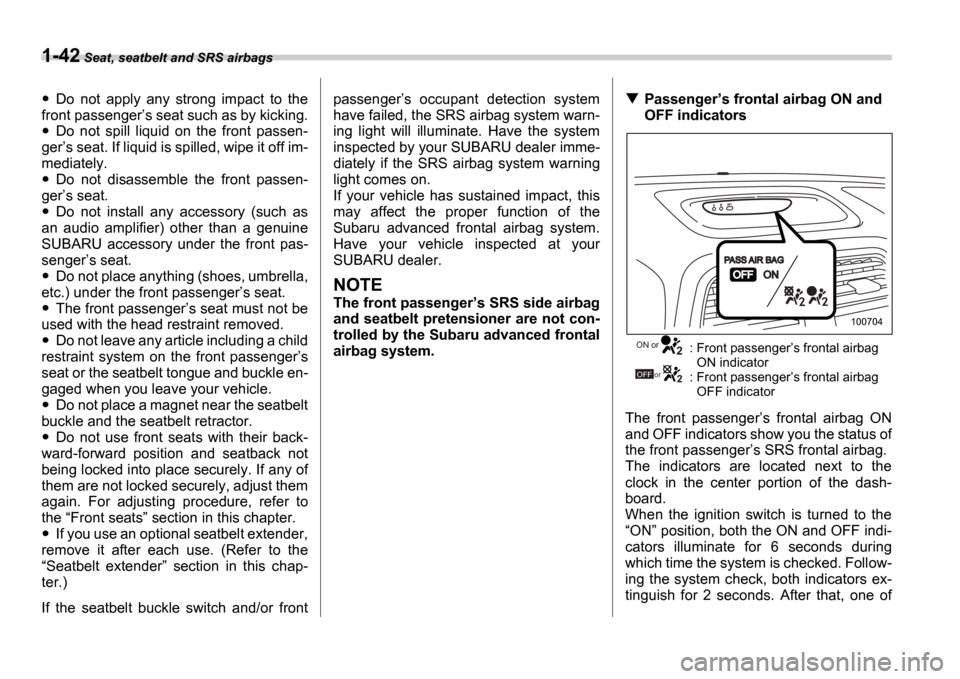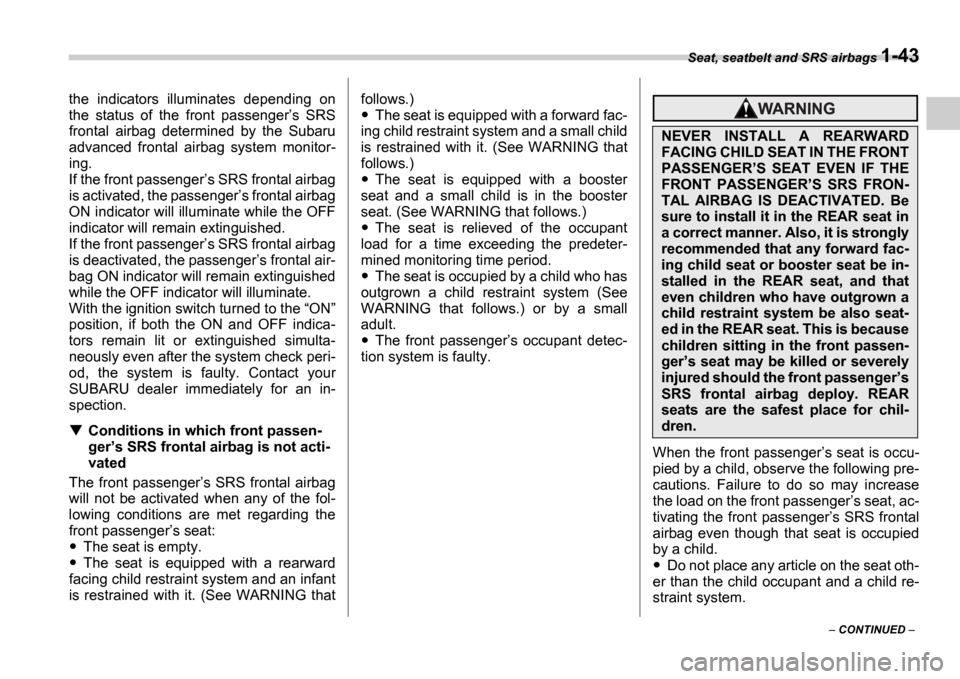2006 SUBARU IMPREZA ignition
[x] Cancel search: ignitionPage 38 of 365

Seat, seatbelt and SRS airbags 1-11
CONTINUED
Expectant mothers
Expectant mothers also need to use the
seatbelts. They should consult their doctor
for specific recommendations. The lap
belt should be worn securely and as low
as possible over the hips, not over the
waist.
Emergency Locking Retrac-
tor (ELR)
The driver s seatbelt has an Emergency
Locking Retractor (ELR).
The emergency locking retractor allows
normal body movement but the retractor
locks automatically during a sudden stop,
impact or if you pull the belt very quickly
out of the retractor.
Automatic/Emergency Lock-
ing Retractor (A/ELR)
Each passenger s seatbelt has an Auto-
matic/Emergency Locking Retractor (A/
ELR). The Automatic/Emergency Locking
Retractor normally functions as an Emer-
gency Locking Retractor (ELR). The A/
ELR has an additional locking mode Au-
tomatic Locking Retractor (ALR) mode in-
tended to secure a child restraint system.
When the seatbelt is once drawn out com-
pletely and is then retracted even slightly,
the retractor locks the seatbelt in that po-
sition and the seatbelt cannot be extend-
ed. As the belt is rewinding, clicks will be
heard which indicate the retractor func-
tions as an ALR. When the seatbelt is re-
tracted fully, the ALR mode is released.
When securing a child restraint system on
the rear seats by the use of the seatbelt,
the seatbelt must be changed over to the
Automatic Locking Retractor (ALR) mode.
When the child restraint system is re-
moved, make sure that the seatbelt re-
tracts fully and the retractor returned to
the Emergency Locking Retractor (ELR)
mode.
For instructions on how to convert the re-
tractor to the ALR mode and restore it to
the ELR mode, see the Child restraint systems
section in this chapter.Seatbelt warning light
and chime
Your vehicle is equipped with a seatbelt
warning device at the driver s seat, as re-
quired by current safety standards. There
is a seatbelt warning light in the combina-
tion meter.
If the driver has not yet fastened the seat-
belt when the ignition switch is turned to
the ON position, the seatbelt warning
light will flash for 6 seconds, to warn that
the seatbelt is unfastened. If the driver s
seatbelt is not fastened, a chime will also
sound simultaneously.
If the driver s seatbelt is still not fastened
6 seconds later, the warning light will re-
main lit for 15 seconds. If the driver s seat-
belt is still not fastened even 15 seconds
later (21 seconds after turning ON the ig-
nition switch), the warning lights will alter-
nate between flashing and steady illumi-
nation at 15-second intervals, and the
chime will sound while the warning light is
flashing.
Alternate flashing and steady illumination
of the warning lights and sounding of the
chime will continue until the driver fastens
the seatbelt.
100100
Page 39 of 365

1-12 Seat, seatbelt and SRS airbags
NOTE
If the driver unfastens the seatbelt af-
ter fastening, the seatbelt warning de-
vice operates as follows according to
the vehicle speed.
At speeds lower than approximate-
ly 9 mph (15 km/h)
The warning light will alternate be-
tween flashing and steady illumina-
tion at 15-second intervals. The
chime will not sound.
At speeds higher than approxi-
mately 9 mph (15 km/h)
The warning light will alternate be-
tween flashing and steady illumina-
tion at 15-second intervals and the
chime will sound while the warning
light is flashing.
It is possible to cancel the warning
operation that follows the 6-second
warning after turning ON the ignition
switch by unfastening and refastening
the driver s seatbelt. When the ignition
switch is turned ON next time, howev-
er, the complete sequence of the warn-
ing operation resumes. For further de-
tails about canceling the warning oper-
ation, please contact your SUBARU
dealer.
Fastening the seatbelt
Never use a belt that is twisted or
reversed. In an accident, this can
increase the risk or severity of in-
jury.
Keep the lap belt as low as possi-
ble on your hips. In a collision,
this spreads the force of the lap
belt over stronger hip bones in-
stead of across the weaker abdo-
men.
Seatbelts provide maximum re-
straint when the occupant sits
well back and upright in the seat.
To reduce the risk of sliding under
the seatbelt in a collision, the
front seatbacks should be always
used in the upright position while
the vehicle is running. If the front
seatbacks are not used in the up-
right position in a collision, the
risk of sliding under the lap belt
and of the lap belt sliding up over
the abdomen will increase, and
both can result in serious internal
injury or death.
Do not put cushions or any other
materials between occupants and
seatbacks or seat cushions. If you
do so, the risk of sliding under the
lap belt and of the lap belt sliding
up over the abdomen will in-
crease, and both can result in se-
rious internal injury or death.
Never place the shoulder belt under
the arm or behind the back. If an ac-
cident occurs, this can increase the
risk or severity of injury.
100101
Page 48 of 365

Seat, seatbelt and SRS airbags 1-21
CONTINUED
System monitors
A diagnostic system continually monitors
the readiness of the seatbelt pretensioner
while the vehicle is being driven. The seat-
belt pretensioners share the control mod-
ule with the SRS airbag system. There-
fore, if any malfunction occurs in a seat-
belt pretensioner, the SRS airbag system
warning light will illuminate. The SRS air-
bag system warning light will show normal
system operation by lighting for approxi-
mately 6 seconds when the ignition switch is turned to the
ON position.
The following components are monitored
by the indicator:
Front sub sensor (Right-hand side)
Front sub sensor (Left-hand side)
Airbag control module (including impact
sensors)
Frontal airbag module (Driver s side)
Frontal airbag module (Front passen-
ger s side)
Side airbag sensor (Center pillar right
hand side)
Side airbag sensor (Center pillar left
hand side)
Side airbag module (Driver s side)
Side airbag module (Front passenger s
side)
Seatbelt pretensioner (Driver s side)
Seatbelt pretensioner (Front passen-
ger s side)
Seatbelt buckle switch (Driver s side)
Seatbelt buckle switch (Front passen-
ger s side)
Driver s seat position sensor
Front passenger s seatbelt tension sen-
sor
Front passenger s occupant detection
system weight sensor
Front passenger s occupant detection
control module
Front passenger s frontal airbag ON
and OFF indicator
All related wiringWhen discarding front seatbelt re-
tractor assemblies or scrapping
the entire vehicle due to collision
damage or for other reasons, con-
sult your SUBARU dealer.
100291
If the warning light exhibits any of
the following conditions, there may
be a malfunction in the seatbelt pre-
tensioners and/or SRS airbag sys-
tem. Immediately take your vehicle
to your nearest SUBARU dealer to
have the system checked. Unless
checked and properly repaired, the
seatbelt pretensioners and/or SRS
airbag will not operate properly in
the event of a collision, which may
increase the risk of injury.
Flashing or flickering of the indi-
cator light
No illumination of the warning
light when the ignition switch is
first turned to the ON position
Continuous illumination of the
warning light
Illumination of the warning light
while driving
Page 69 of 365

1-42 Seat, seatbelt and SRS airbags
Do not apply any strong impact to the
front passenger s seat such as by kicking.
Do not spill liquid on the front passen-
ger s seat. If liquid is spilled, wipe it off im-
mediately.
Do not disassemble the front passen-
ger s seat.
Do not install any accessory (such as
an audio amplifier) other than a genuine
SUBARU accessory under the front pas-
senger s seat.
Do not place anything (shoes, umbrella,
etc.) under the front passenger s seat.
The front passenger s seat must not be
used with the head restraint removed.
Do not leave any article including a child
restraint system on the front passenger s
seat or the seatbelt tongue and buckle en-
gaged when you leave your vehicle.
Do not place a magnet near the seatbelt
buckle and the seatbelt retractor.
Do not use front seats with their back-
ward-forward position and seatback not
being locked into place securely. If any of
them are not locked securely, adjust them
again. For adjusting procedure, refer to
the Front seats section in this chapter.
If you use an optional seatbelt extender,
remove it after each use. (Refer to the Seatbelt extender section in this chap-
ter.)
If the seatbelt buckle switch and/or front passenger
s occupant detection system
have failed, the SRS airbag system warn-
ing light will illuminate. Have the system
inspected by your SUBARU dealer imme-
diately if the SRS airbag system warning
light comes on.
If your vehicle has sustained impact, this
may affect the proper function of the
Subaru advanced frontal airbag system.
Have your vehicle inspected at your
SUBARU dealer.
NOTE
The front passenger s SRS side airbag
and seatbelt pretensioner are not con-
trolled by the Subaru advanced frontal
airbag system.
Passenger s frontal airbag ON and
OFF indicators
: Front passenger s frontal airbag
ON indicator
: Front passenger s frontal airbag
OFF indicator
The front passenger s frontal airbag ON
and OFF indicators show you the status of
the front passenger s SRS frontal airbag.
The indicators are located next to the
clock in the center portion of the dash-
board.
When the ignition switch is turned to the ON position, both the ON and OFF indi-
cators illuminate for 6 seconds during
which time the system is checked. Follow-
ing the system check, both indicators ex-
tinguish for 2 seconds. After that, one of
100704
ON or
OFF or
Page 70 of 365

Seat, seatbelt and SRS airbags 1-43
CONTINUED
the indicators illuminates depending on
the status of the front passenger
s SRS
frontal airbag determined by the Subaru
advanced frontal airbag system monitor-
ing.
If the front passenger s SRS frontal airbag
is activated, the passenger s frontal airbag
ON indicator will illuminate while the OFF
indicator will remain extinguished.
If the front passenger s SRS frontal airbag
is deactivated, the passenger s frontal air-
bag ON indicator will remain extinguished
while the OFF indicator will illuminate.
With the ignition switch turned to the ON
position, if both the ON and OFF indica-
tors remain lit or extinguished simulta-
neously even after the system check peri-
od, the system is faulty. Contact your
SUBARU dealer immediately for an in-
spection.
Conditions in which front passen-
ger s SRS frontal airbag is not acti-
vated
The front passenger s SRS frontal airbag
will not be activated when any of the fol-
lowing conditions are met regarding the
front passenger s seat:
The seat is empty.
The seat is equipped with a rearward
facing child restraint system and an infant
is restrained with it. (See WARNING that follows.)
The seat is equipped with a forward fac-
ing child restraint system and a small child
is restrained with it. (See WARNING that
follows.)
The seat is equipped with a booster
seat and a small child is in the booster
seat. (See WARNING that follows.)
The seat is relieved of the occupant
load for a time exceeding the predeter-
mined monitoring time period.
The seat is occupied by a child who has
outgrown a child restraint system (See
WARNING that follows.) or by a small
adult.
The front passenger s occupant detec-
tion system is faulty.
When the front passenger s seat is occu-
pied by a child, observe the following pre-
cautions. Failure to do so may increase
the load on the front passenger s seat, ac-
tivating the front passenger s SRS frontal
airbag even though that seat is occupied
by a child.
Do not place any article on the seat oth-
er than the child occupant and a child re-
straint system.
NEVER INSTALL A REARWARD
FACING CHILD SEAT IN THE FRONT
PASSENGER S SEAT EVEN IF THE
FRONT PASSENGER S SRS FRON-
TAL AIRBAG IS DEACTIVATED. Be
sure to install it in the REAR seat in
a correct manner. Also, it is strongly
recommended that any forward fac-
ing child seat or booster seat be in-
stalled in the REAR seat, and that
even children who have outgrown a
child restraint system be also seat-
ed in the REAR seat. This is because
children sitting in the front passen-
ger s seat may be killed or severely
injured should the front passenger s
SRS frontal airbag deploy. REAR
seats are the safest place for chil-
dren.
Page 71 of 365

1-44 Seat, seatbelt and SRS airbags
Do not place more than one child on the
seat.
Do not install any accessory such as a
table or TV onto the seatback.
Do not store a heavy load in the seat-
back pocket.
Do not allow the rear seat occupant to
place his/her hands or legs on the front
passenger s seatback, or allow him/her to
pull the seatback.
If the front passenger s frontal air-
bag ON indicator illuminates and the
OFF indicator extinguishes even
when an infant or a small child is in
a child restraint system (including
booster seat)
Turn the ignition switch to the OFF posi-
tion if the front passenger s frontal airbag
ON indicator illuminates and the OFF indi-
cator extinguishes even when an infant or
a small child is in a child restraint system
(including booster seat). Remove the child
restraint system from the seat. By refer-
ring to the child restraint manufacturer s
recommendations as well as the child re-
straint system installation procedures in
the Seat heater (if equipped) section in
this chapter, correctly install the child re-
straint system. Turn the ignition switch to
the ON position and make sure that the
front passenger s frontal airbag ON indi- cator goes out and the OFF indicator
comes on.
If still the ON indicator remains illuminated
while the OFF indicator extinguishes, take
the following actions.
Ensure that no article is placed on the
seat other than the child restraint system
and the child occupant.
Ensure that there is no article left in the
seatback pocket.
Ensure that the backward-forward posi-
tion and seatback of front passenger s
seat are locked into place securely by
moving the seat back and forth.
If the ON indicator still illuminates while
the OFF indicator extinguishes after tak-
ing relevant corrective actions described
above, relocate the child restraint system
to the rear seat and immediately contact
your SUBARU dealer for an inspection.
NOTE
When a child who has outgrown a child
restraint system or a small adult is
seated in the front passenger s seat,
the Subaru advanced frontal airbag
system may or may not activate the
front passenger s SRS frontal airbag
depending on the occupant s seating
posture. If the front passenger s SRS
frontal airbag is activated (the ON indi- cator illuminates while the OFF indica-
tor extinguishes), take the following
actions.
Ensure that no article is placed on
the seat other than the occupant.
Ensure that there is no article left in
the seatback pocket.
If the ON indicator still illuminates
while the OFF indicator extinguishes
despite the fact that the actions noted
above have been taken, seat the child/
small adult in the rear seat and immedi-
ately contact your SUBARU dealer for
an inspection. Even if the system has
passed the dealer inspection, it is rec-
ommended that on subsequent trips
the child/small adult always take the
rear seat.
Children who have outgrown a child re-
straint system should always wear the
seatbelt irrespective of whether the airbag
is deactivated or activated.
Conditions in which front passen-
ger s SRS frontal airbag is activated
The front passenger s SRS frontal airbag
will be activated for deployment upon im-
pact when any of the following conditions
is met regarding the front passenger s
seat.
When the seat is occupied by an adult.
Page 72 of 365

Seat, seatbelt and SRS airbags 1-45
CONTINUED
When a heavy article is placed on the
seat.
When the front passenger s seat is occu-
pied by an adult, observe the following
precautions. Failure to do so may lessen
the load on the front passenger s seat, de-
activating the front passenger s SRS fron-
tal airbag despite the fact that the seat is
occupied by an adult.
Do not allow the rear seat occupant to
lift the front passenger s seat cushion us-
ing his/her feet.
Do not place any article under the front
passenger s seat, or squeeze any article
from behind and under the seat. This may
lift the seat cushion.
Do not squeeze any article between the
front passenger s seat and side trim/pillar,
door or center console box. This may lift
the seat cushion.
If the passenger s frontal airbag
OFF indicator illuminates and the
ON indicator extinguishes even
when the front passenger s seat is
occupied by an adult
This can be caused by the adult incorrect-
ly sitting in the front passenger s seat.
Turn the ignition switch to the OFF posi-
tion. Ask the front passenger to set the
seatback to the upright position, sit up
straight in the center of the seat cushion, correctly fasten the seatbelt, position his/
her legs out forward, and adjust the seat
to the rearmost position. Turn the ignition
switch to the
ON position. If the OFF in-
dicator remains illuminated while the ON
indicator remains extinguished, take the
following actions.
Turn the ignition switch to the OFF po-
sition.
Ensure that there is no article, book,
shoe, or other object trapped under the
seat, at the rear of the seat, or on the side
of the seat.
Ensure that the backward-forward posi-
tion and seatback of front passenger s
seat are locked into place securely by
moving the seat back and forth.
Next, turn the ignition switch to the ON
position and wait 6 seconds to allow the
system to complete self-checking. Follow-
ing the system check, both indicators ex-
tinguish for 2 seconds. Now, the ON indi-
cator should illuminate while the OFF indi-
cator remains extinguished.
If the OFF indicator still illuminates while
the ON indicator remains extinguished,
ask the occupant to move to the rear seat
and immediately contact your SUBARU
dealer for an inspection.
Effect vehicle modifications made
for persons with disabilities may
have on Subaru advanced frontal
airbag system operation (U.S. only)
Changing or moving any parts of the front
seats, seat belts, front bumper, front side
frame, instrument panel, combination
meter, steering wheel, steering column,
tire, suspension or floor panel can affect
the operation of the Subaru advanced air-
bag system. If you have any questions,
you may contact the following Subaru dis-
tributors:
Subaru of America, Inc.
Customer Dealer Services Department
P.O. Box 6000
Cherry Hill, NJ 08034-6000
1-800-SUBARU3 (1-800-782-2783)
Schuman Carriage Motors, Inc.
1234 South Beretania Street, Honolulu, HI
96814
808-592-4497
Triple J Enterprises, Inc.
P.O. Box 6066, Tamuning, Guam 96931
671-646-9126
Page 74 of 365

Seat, seatbelt and SRS airbags 1-47
CONTINUED
Operation
A) Drivers side
B) Passenger s side
1) SRS AIRBAGs deploy as soon as a collision occurs.
2) After deployment, SRS AIRBAGs start to deflate im mediately so that the drivers vision is not
obstructed.
A B
1
2
100619
The SRS airbag can function only when
the ignition switch is in the ON position.
The Subaru advanced frontal airbag sys-
tem is designed to determine the activa-
tion or deactivation condition of the front
passenger s SRS frontal airbag depend-
ing on the total load on the front passen-
ger s seat monitored by the front passen-
ger s occupant detection system weight
sensor. For this reason, only the driver s
SRS frontal airbag may deploy in the
event of a collision, but this does not mean
failure of the system.
If the front sub sensors inside both front
fenders and the impact sensors in the air-
bag control module detect a predeter-
mined amount of force during a frontal col-
lision, the control module sends signals to
the airbag module(s) (only driver s module
or both driver s and front passenger s
modules) instructing the module(s) to in-
flate the SRS frontal airbag(s). The driv-
er s and front passenger s SRS frontal air-
bags use dual stage inflators. The two in-
flators of each airbag are triggered either
sequentially or simultaneously, depending
on the severity of impact, backward-for-
ward adjustment of the driver s seat posi-
tion and fastening/unfastening of the seat-
belt in the case of the driver s SRS frontal
airbag and depending on the severity of
impact and the total load on the seat in the